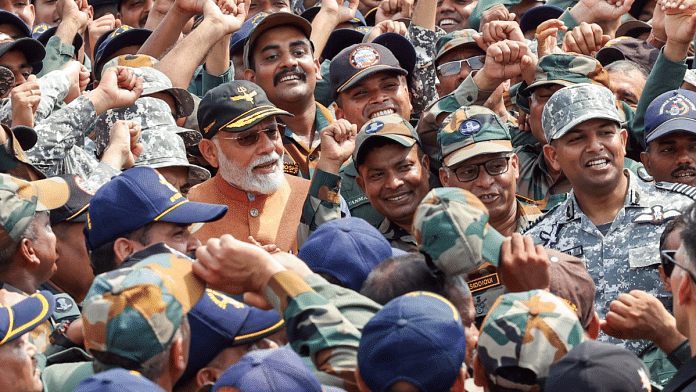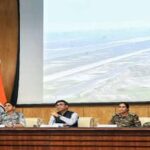Gurpatwant Singh Pannun, a designated terrorist under Indian law and the self-proclaimed legal counsel of the banned organisation Sikhs for Justice (SFJ), has long functioned as a vocal agent of Khalistani extremism. Now a naturalised US citizen operating from New York, Pannun continues to issue venomous statements against India, despite facing multiple terrorism and sedition charges and being wanted in nearly two dozen cases.
In his latest outburst, Pannun swiftly echoed Pakistan’s fabricated narrative following the ISPR’s outrageous 9 May claim that Indian missiles from Adampur had struck Amritsar. Within hours, using affiliated social media accounts such as @SFJGenCounsel, he parroted the line that Sikhs were being targeted by the Indian State. His provocative question—“Why are Sikhs target?”—was immediately followed by the inflammatory slogan, “Modi’s missiles kill Sikhs – Khalistan is the answer!”
The speed and substance of Pannun’s reaction leave little to the imagination. That his messaging emerged within hours of the DG ISPR’s wild and disproven assertions clearly demonstrates that he is either a willing proxy or an unabashed mouthpiece of Pakistan’s pernicious propaganda machinery. Far from championing any genuine Sikh cause, Pannun’s statements serve as an echo chamber for the very forces that have historically suppressed minority rights within Pakistan, including those of its own beleaguered Sikh population.
What makes Pannun’s radicalism all the more disingenuous is his personal origin—he hails from Khankot village, just outside the municipal limits of Amritsar on the Grand Trunk Road to Jalandhar. This locality is hardly a site of grievance or alienation, yet he has repackaged himself as the global face of separatism. In January 2025, his quest for attention saw him reportedly “gatecrash” an event linked to US President Donald Trump—another publicity stunt designed to mask the hollowness of his cause with spectacle and provocation.
Sukhjinder Singh Randhawa, Congress Lok Sabha MP from Gurdaspur, conducted a tour earlier this week of border villages in the Bamial sector (Pathankot) along the Ravi River, as well as settlements in the Dera Baba Nanak, Dhariwal, and Kalanaur sectors. In a personal conversation with this writer, Randhawa shared, “Even in villages like Naushehra Dhalla and Dhangeran—situated beyond the Ravi’s banks—farmers reported not a single bullet, let alone missiles or drones, penetrated Indian airspace.” He added that the administration had ordered limited evacuations, but life remained peaceful. People felt secure because India’s air defence systems had neutralised every threat.
While criticising the poor condition of roads, education, and healthcare in these frontier regions, Randhawa unequivocally demanded the resurrection of the Border Area Development Project with 100 per cent central funding. He noted that his constituency had borne the brunt of not only the India-Pakistan wars of 1965 and 1971 but also the Pakistan-abetted proxy war of terrorism through the 1980s until 1994. Yet, he observed, “Operation Sindoor’s aftermath saw normalcy, not panic. Pakistan’s fireworks [atish-baazi] failed miserably.”
Pakistan’s coordinated disinformation campaign betrays three fundamental miscalculations:
Desperation after defeat: The wild allegations demonstrate that Pakistan’s military and political establishment is discouraged, defeated, and running short of ideas after the successful Indian strikes. When satellite imagery and on-ground reality so easily disprove your claims, it indicates poor strategic thinking born of desperation.
Underestimating native intelligence and commonsense: The crude attempt to drive a wedge between Sikhs and India assumes that Punjabis in general, and Sikhs in particular, are naïve enough to believe such transparent propaganda. In an age where private satellite imagery is readily available and even civilian aircraft flight paths are trackable online, such easily debunked claims insult the intelligence of the target audience.
Living in the past: Pakistan seems to believe that scripts which found limited traction among a microscopic minority of misguided youth in the 1980s and early 1990s will work in today’s interconnected world. They fail to recognise that today’s Sikh community is globally integrated, technologically savvy, and far more aware of Pakistan’s own poor treatment of minorities.
Pakistan’s propaganda efforts occur against the backdrop of significant changes in global geopolitics. The United States now views India as a crucial partner in the QUAD—a strategic grouping that, while not a formal military alliance, forms a linchpin of America’s strategy to contain China’s expanding influence in the Indo-Pacific region.
Even China’s supposed support for Pakistan was nothing more than diplomatic boilerplate. When Chinese Foreign Minister Wang Yi spoke with Pakistan’s Ishaq Dar, he merely reiterated that China would “continue to stand firmly by Pakistan in upholding its sovereignty, territorial integrity, and national independence”—standard diplomatic language that stops well short of endorsing Pakistan’s specific actions or claims.
Pakistan’s economic fragility further undermines its position. The country recently received a $1 billion tranche from the International Monetary Fund as part of its $7 billion Extended Fund Facility lending programme. India abstained from voting on this bailout, citing concerns over Pakistan’s poor track record with IMF programmes and the possibility of “misuse of debt financing funds for state-sponsored cross-border terrorism.”
This financial support resembles an extra oxygen cylinder for a patient on a ventilator—a temporary fix for a systemic problem. Meanwhile, Pakistan faces serious internal challenges, including an intensifying insurgency in Balochistan, where separatist groups like the Balochistan Liberation Army continue to challenge the Pakistani state’s authority.
While President Trump claimed some role in facilitating the ceasefire between India and Pakistan on 10 May 2025, no statements indicate any active or formal US mediation that would breach the Simla Agreement. Rather, they reflect America’s natural concern—as a global power—that a flashpoint between two nuclear-armed neighbours in South Asia be defused quickly.
Pakistan’s political establishment and military high command should now realise that their synchronised propaganda offensive—carried out in concert with fringe figures like Gurpatwant Singh Pannun—has not only failed to achieve its objectives but has collapsed under the weight of its own falsehoods. Instead of inciting unrest or fear, it has exposed a desperate attempt to revive outdated narratives in a geopolitical and domestic landscape that has moved far beyond the vulnerabilities of the 1980s.
The near-instant alignment between the DG ISPR’s ludicrous missile claims and Pannun’s incendiary statements reveals more than coordination—it reveals orchestration. But neither misinformation nor mischief found traction. On the contrary, first-hand accounts from none other than a sitting opposition party MP—Sukhjinder Singh Randhawa—who toured the very villages supposedly under threat, paint a picture of calm, resilience, and public trust in India’s air defence and security apparatus.
Just as Pakistan’s Chinese-supplied missiles and drones were intercepted with near-total precision, its information warfare too was neutralised—not by counter-propaganda, but by hard evidence, satellite imagery, and local testimony.
In an age of real-time verification, global transparency, and hardened Indian resolve, Pakistan’s disinformation playbook is no longer just obsolete—it is dangerously self-defeating. What remains is not a blow to India, but a mirror held up to Pakistan’s own strategic bankruptcy and narrative decay.
(Edited by Prashant)








